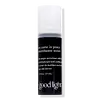What's inside
What's inside
 Key Ingredients
Key Ingredients

 Benefits
Benefits

 Concerns
Concerns

 Ingredients Side-by-side
Ingredients Side-by-side

Aloe Barbadensis Leaf Juice
Skin ConditioningWater
Skin ConditioningPropanediol
SolventSqualane
EmollientGlycerin
HumectantSodium Citrate
BufferingBeta-Glucan
Skin ConditioningLysolecithin
EmulsifyingSclerotium Gum
Emulsion StabilisingPullulan
Xanthan Gum
EmulsifyingCeramide NP
Skin ConditioningCeramide Ns
Skin ConditioningCeramide AP
Skin ConditioningCeramide Eos
Skin ConditioningCeramide EOP
Skin ConditioningMusa Sapientum Leaf Extract
Skin ConditioningTocopherol
AntioxidantCalcium Gluconate
HumectantCetyl Alcohol
EmollientCaprylyl Glycol
EmollientCeteareth-25
CleansingArginine
MaskingSilica
AbrasiveCaprooyl Phytosphingosine
Skin ConditioningCaprooyl Sphingosine
Skin ConditioningCholesterol
EmollientGluconolactone
Skin ConditioningLactic Acid
BufferingHelianthus Annuus Seed Oil
EmollientSodium Benzoate
MaskingBehenic Acid
CleansingAloe Barbadensis Leaf Juice, Water, Propanediol, Squalane, Glycerin, Sodium Citrate, Beta-Glucan, Lysolecithin, Sclerotium Gum, Pullulan, Xanthan Gum, Ceramide NP, Ceramide Ns, Ceramide AP, Ceramide Eos, Ceramide EOP, Musa Sapientum Leaf Extract, Tocopherol, Calcium Gluconate, Cetyl Alcohol, Caprylyl Glycol, Ceteareth-25, Arginine, Silica, Caprooyl Phytosphingosine, Caprooyl Sphingosine, Cholesterol, Gluconolactone, Lactic Acid, Helianthus Annuus Seed Oil, Sodium Benzoate, Behenic Acid
Water
Skin ConditioningDipropylene Glycol
HumectantPropanediol
SolventCaprylic/Capric Triglyceride
MaskingGlycerin
Humectant1,2-Hexanediol
Skin ConditioningOlea Europaea Fruit Oil
MaskingBakuchiol
AntimicrobialDaucus Carota Sativa Seed Oil
EmollientMoringa Oleifera Seed Oil
EmollientLactococcus Ferment Lysate
Skin ConditioningTanacetum Annuum Flower Oil
MaskingCetearyl Alcohol
EmollientBetaine
HumectantC14-22 Alcohols
Emulsion StabilisingGlyceryl Stearate
EmollientXanthan Gum
EmulsifyingC12-20 Alkyl Glucoside
EmulsifyingPhenylpropanol
MaskingTetrasodium Iminodisuccinate
Levulinic Acid
PerfumingSodium Levulinate
Skin ConditioningGlucose
HumectantAcrylates/C10-30 Alkyl Acrylate Crosspolymer
Emulsion StabilisingTromethamine
BufferingSodium Chloride
MaskingEthylhexylglycerin
Skin ConditioningWater, Dipropylene Glycol, Propanediol, Caprylic/Capric Triglyceride, Glycerin, 1,2-Hexanediol, Olea Europaea Fruit Oil, Bakuchiol, Daucus Carota Sativa Seed Oil, Moringa Oleifera Seed Oil, Lactococcus Ferment Lysate, Tanacetum Annuum Flower Oil, Cetearyl Alcohol, Betaine, C14-22 Alcohols, Glyceryl Stearate, Xanthan Gum, C12-20 Alkyl Glucoside, Phenylpropanol, Tetrasodium Iminodisuccinate, Levulinic Acid, Sodium Levulinate, Glucose, Acrylates/C10-30 Alkyl Acrylate Crosspolymer, Tromethamine, Sodium Chloride, Ethylhexylglycerin
 Reviews
Reviews

Ingredients Explained
These ingredients are found in both products.
Ingredients higher up in an ingredient list are typically present in a larger amount.
Glycerin is already naturally found in your skin. It helps moisturize and protect your skin.
A study from 2016 found glycerin to be more effective as a humectant than AHAs and hyaluronic acid.
As a humectant, it helps the skin stay hydrated by pulling moisture to your skin. The low molecular weight of glycerin allows it to pull moisture into the deeper layers of your skin.
Hydrated skin improves your skin barrier; Your skin barrier helps protect against irritants and bacteria.
Glycerin has also been found to have antimicrobial and antiviral properties. Due to these properties, glycerin is often used in wound and burn treatments.
In cosmetics, glycerin is usually derived from plants such as soybean or palm. However, it can also be sourced from animals, such as tallow or animal fat.
This ingredient is organic, colorless, odorless, and non-toxic.
Glycerin is the name for this ingredient in American English. British English uses Glycerol/Glycerine.
Learn more about GlycerinPropanediol is an all-star ingredient. It softens, hydrates, and smooths the skin.
It’s often used to:
Propanediol is not likely to cause sensitivity and considered safe to use. It is derived from corn or petroleum with a clear color and no scent.
Learn more about PropanediolWater. It's the most common cosmetic ingredient of all. You'll usually see it at the top of ingredient lists, meaning that it makes up the largest part of the product.
So why is it so popular? Water most often acts as a solvent - this means that it helps dissolve other ingredients into the formulation.
You'll also recognize water as that liquid we all need to stay alive. If you see this, drink a glass of water. Stay hydrated!
Learn more about WaterXanthan gum is used as a stabilizer and thickener within cosmetic products. It helps give products a sticky, thick feeling - preventing them from being too runny.
On the technical side of things, xanthan gum is a polysaccharide - a combination consisting of multiple sugar molecules bonded together.
Xanthan gum is a pretty common and great ingredient. It is a natural, non-toxic, non-irritating ingredient that is also commonly used in food products.
Learn more about Xanthan Gum